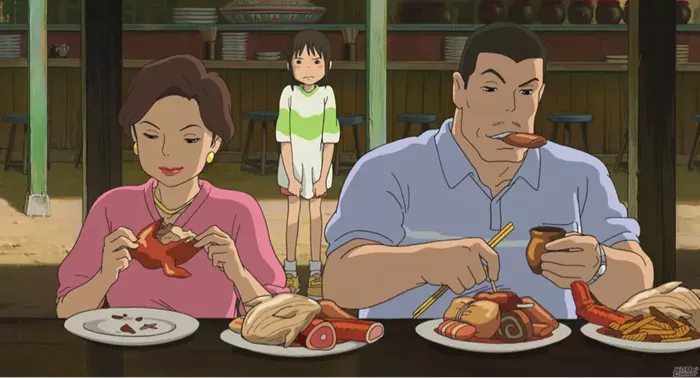Studio Ghibli’s “Spirited Away,” directed by the legendary Hayao Miyazaki, is a timeless masterpiece that captivates audiences with its enchanting story, stunning animation, and richly detailed world. Among the many elements that contribute to the film’s immersive experience, the food stands out as a central theme, offering a glimpse into the magical and whimsical realm of the spirit bathhouse. In this article, we will delve into the diverse array of food featured in “Spirited Away”, exploring its significance, cultural references, and mouthwatering appeal.
Culinary World of “Spirited Away”
Setting the Scene
“Spirited Away” follows the journey of a young girl named Chihiro as she navigates a mysterious and fantastical spirit world after her parents are transformed into pigs. Central to her experiences in this world is the bathhouse, a bustling establishment where spirits come to relax and rejuvenate. It is within the bathhouse’s walls that Chihiro encounters a wide variety of delectable dishes and culinary delights.
Cultural Influences
Miyazaki drew inspiration from various cultural and culinary traditions in creating the food of “Spirited Away.” Japanese cuisine, with its emphasis on fresh, seasonal ingredients and meticulous preparation, is evident throughout the film. Additionally, elements of traditional Japanese folklore and mythology are woven into the culinary landscape, adding depth and meaning to the food featured in the story.
Exploring the Food of “Spirited Away”
Onigiri (Rice Balls)
Onigiri, or rice balls, make frequent appearances in “Spirited Away” as a staple snack enjoyed by the characters. These simple yet satisfying treats are typically made by shaping rice into triangles or spheres and wrapping them in seaweed. In the bathhouse, onigiri are often seen being prepared and consumed by both workers and guests, reflecting the everyday comfort and familiarity of this classic Japanese dish.
Soba Noodles
Soba noodles, a traditional Japanese noodle made from buckwheat flour, are featured prominently in several scenes of “Spirited Away.” In one memorable sequence, Chihiro’s friend and ally, Lin, serves her a steaming bowl of soba noodles as a gesture of kindness and hospitality. The noodles are depicted with mouthwatering detail, their savory aroma and delicate texture inviting viewers to savor the experience alongside the characters.
Dango (Sweet Rice Dumplings)
Dango, sweet rice dumplings skewered on bamboo sticks, make a whimsical appearance in “Spirited Away.” In one scene, Chihiro encounters a spirit named Kaonashi (No-Face) who offers her a plate of dango as a gesture of friendship. The colorful, bite-sized dumplings are depicted with a playful charm, their soft, chewy texture and sweet flavor adding a touch of whimsy to the film’s culinary landscape.
Oshiruko (Sweet Red Bean Soup)
Oshiruko, a traditional Japanese dessert made from sweet red bean paste, is featured in a heartwarming scene in “Spirited Away.” Chihiro’s journey leads her to encounter a spirit named Haku, who offers her a warm bowl of oshiruko to comfort her during a moment of uncertainty. The rich, velvety texture of the soup and the sweetness of the red bean paste provide a comforting respite for Chihiro and a poignant reminder of the power of food to nourish both body and soul.
Tempura (Battered and Deep-Fried Ingredients)
Tempura, a popular Japanese dish consisting of battered and deep-fried ingredients, makes a mouthwatering appearance in “Spirited Away.” In one scene, Chihiro and her companions visit a bustling street market where they encounter a variety of vendors selling tempura-fried delicacies. The crispy, golden-brown exterior of the tempura and the tender, flavorful ingredients within offer a tantalizing sensory experience for both the characters and the audience.
Symbolism and Significance of Food in “Spirited Away”
Nourishment and Hospitality
Food plays a central role in “Spirited Away” as a symbol of nourishment, hospitality, and connection. Throughout the film, characters share meals together as a means of forging bonds, expressing kindness, and providing comfort in times of adversity. The act of preparing and sharing food becomes a powerful expression of compassion and solidarity, transcending language and cultural barriers.
Transformation and Transcendence
In “Spirited Away,” food serves as a metaphor for transformation and transcendence, reflecting the film’s themes of growth, change, and the passage of time. Chihiro’s journey in the spirit world is paralleled by her experiences with food, as she encounters new flavors, textures, and culinary traditions that broaden her perspective and deepen her understanding of the world around her. Through her interactions with food, Chihiro undergoes a profound personal transformation, emerging stronger, wiser, and more resilient.
Cultural Heritage and Identity
The food of “Spirited Away” also serves as a celebration of Japanese cultural heritage and identity. From traditional dishes like onigiri and soba noodles to iconic desserts like oshiruko and dango, the film showcases the rich diversity and culinary craftsmanship of Japanese cuisine. Through its vibrant portrayal of food, “Spirited Away” invites viewers to appreciate the beauty and complexity of Japanese culture and to savor the timeless traditions that have shaped its culinary legacy.
Conclusion
The food of “Spirited Away” is more than just a visual feast; it is a central theme that enriches the film’s narrative, deepens its characters, and invites viewers into a world of wonder and enchantment. From the humble simplicity of onigiri to the exquisite elegance of soba noodles and the whimsical charm of dango, each culinary creation in the film is imbued with meaning, symbolism, and cultural significance. Through its celebration of food, “Spirited Away” reminds us of the power of nourishment, the importance of hospitality, and the timeless traditions that connect us to our shared humanity.

